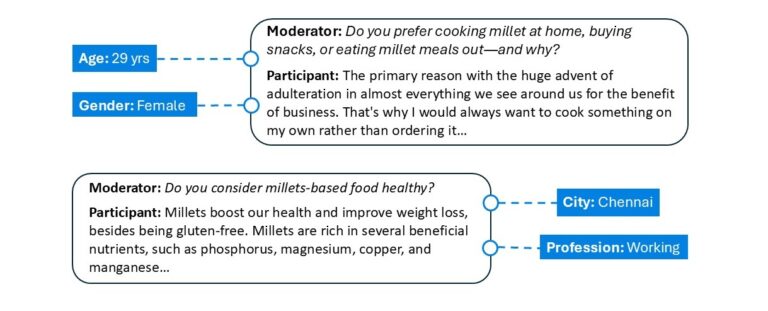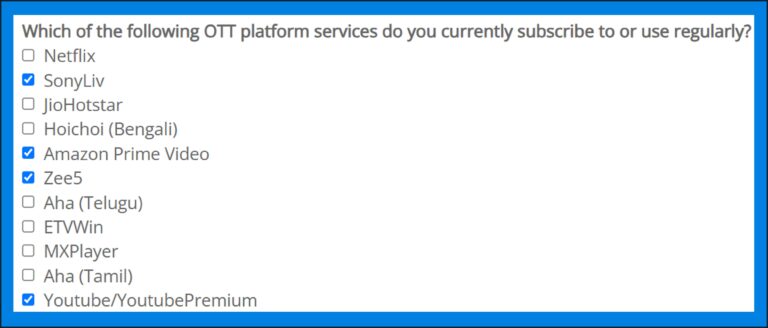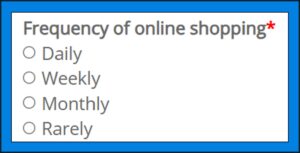Qualitative vs Quantitative Research: How to Choose the Right Approach
Every research project begins with a question. But how you find the answer depends on one crucial decision – whether to use qualitative or quantitative research. For some, the qualitative vs quantitative choice feels obvious – numbers for scale, words for meaning. Yet, in practice, the two approaches overlap, complement, and often coexist.
At ThinkSurvey, we’ve seen this across both academic studies and market research projects, from psychology professors exploring emotional resilience to marketing managers testing new product concepts. This blog dives deep into what differentiates qualitative and quantitative research, when to use each, and how both can be seamlessly executed.
What Do “Qualitative” and “Quantitative” Really Mean?
In the simplest terms:
- Qualitative research explores the “why” and “how” – the thoughts, emotions, and motivations behind people’s thought process and decisions.
- Quantitative research measures the “what” and “how much” – observable behaviours, attitudes, or outcomes that can be expressed in numbers.
Think of it this way:
If you want to understand why customers love a particular brand, you conduct interviews or focus groups (qualitative).
If you want to measure how many customers prefer one brand over another, you run a large-scale survey (quantitative).
Irrespective of Qualitative vs Quantitative debate in your organisation or among research groups, both methods are crucial – and comes under the purview of strategic market research. The best insights often emerge when they’re combined strategically.
What is Qualitative Research?
Qualitative research is all about exploring depth over breadth. It focuses on rich, detailed data that reveal people’s perceptions, experiences, and reasoning. Unravelling the real human stories.
Key Characteristics:
- Nature of data: Textual, descriptive, non-numerical
- Goal: To explore meanings, concepts, and underlying motivations
- Sample size: Small but detailed (usually 10–50 participants)
- Approach: Open-ended and exploratory
- Analysis: Thematic or interpretive – researchers look for patterns in responses
Common Methods of Conducting Qualitative Research
- In-depth Interviews (IDIs): One-on-one conversations exploring personal experiences or opinions.
- Focus Group Discussions (FGDs): Group settings that surface collective views or emotional triggers.
- Ethnography: Observing participants in their natural environment (traditional – offline, modern – online)
- Open-ended Questionnaires: Text-based responses gathered online, often through platforms like ThinkSurvey.
- Content or Text Analysis: Reviewing written, visual, or digital content to interpret themes.
Real-word examples: Qualitative Market Research
A brand manager for automobile brand might capture consumer insights through open-ended questionnaires, on how they would describe India in One Line. The discussion reveals emotional cues and language that later builds foundation for marketing campaign messaging.
Similarly, an academic researcher might start with 20 in-depth interviews with Indian citizens on exploring ethically minded consumer behaviour. The goal isn’t to generalize but to understand their inner narratives – the peer pressures, comparisons, and usual behaviour behind over-purchasing or minimal purchasing habits.
How ThinkSurvey Supports Qualitative Studies
At ThinkSurvey, qualitative data collection can be simplified through:
- Targeted participant recruitment – researchers can recruit participants based on specific demographics, interests, or expertise.
- Open-ended question modules – capture detailed narratives in text or voice format.
- Response analysis – get expert thematic analysis done on the responses collected
Whether you’re a marketing professional exploring brand perceptions or an academic studying behavioural theme, these qualitative research methods enable you to collect in-depth, high-quality responses easily.
Looking to streamline Qualitative Marketing Studies?
Access targeted, high-quality participants.
What is Quantitative Research?
Quantitative research is structured, numerical, and measurable. It seeks to quantify relationships, test hypotheses, and draw statistically valid conclusions.
Key Characteristics:
- Nature of data: Numerical, categorical, or coded
- Goal: To test hypotheses and measure the magnitude of patterns
- Sample size: Large and representative (often 100–1000+)
- Approach: Structured and deductive
- Analysis: Statistical – correlations, regressions, frequencies, and averages
Common Methods of Conducting Quantitative Research
- Structured Surveys: Closed-ended questions using scales (e.g., Likert scales, rating scales).
- Experiments: Controlled testing of variables (e.g., A/B testing in marketing).
- Observational Studies: Quantifying behaviours or patterns in real settings.
- Secondary Data Analysis: Using large existing datasets for numerical insights.
Real-word examples: Quantitative Market Research
A fashion brand launching a new beaty product runs an online survey with 1,000 women respondents to measure brand recall, new product features, and Net Promoter Score (NPS). The findings guide product development and marketing spend for a successful research-led product launch in the market.
Similarly, a political researcher testing the impact of fake news on Indian voters during election season collects responses from 500 citizens using a structured questionnaire with images and 5-point scales. The goal is statistical validation — not narrative detail.
How ThinkSurvey Supports Quantitative Studies
- Representative sampling – recruit participants across target segments (professionals, students, consumers).
- Randomization and branching logic – ensure only the right opinions are captured.
- Run national level studies – easily collect 1000+ responses from participants across India.
- Analysis and support – get complete go-to-market recommendations and consulting from our experts.
Quantitative research methods thrive on scale and precision, and ThinkSurvey’s panel-based model ensures you can collect robust data without manual coordination or bias.
Conduct effective Quantitative Marketing Studies
Run national level data collection campaigns
When to Use Qualitative or Quantitative – or Both
Choosing between qualitative vs quantitative research depends on your research goal.
Use Qualitative When:
- You’re exploring a new topic or market.
- You need to understand emotions, motivations, or perceptions.
- The goal is idea generation or conceptual development.
Use Quantitative When:
- You’re testing a hypothesis or measuring a variable.
- You want statistical confidence in findings.
- You need data for decision-making or predictive modeling.
Use Both (Mixed-Methods) When:
- You want to explore first, then validate.
- Your study involves both meaning and measurement.
- You need a holistic perspective.
Real World Examples: The Power of Combining Qualitative and Quantitative Studies
Mixed-method studies are best ways to move away from the debate of choosing either of qualitative vs quantitative research. Below are some real-word case studies:
A millet-based food products startup wanted to understand consumers’ awareness, motivation and hesitation towards healthy eating:
- Phase 1 – Qualitative: Conducted 20 in-depth interviews to uncover key themes – eating habits, preference, taste, affordability.
- Phase 2 – Quantitative: Designed a 25-question online survey based on those themes and distribute it to 600+ citizens across 108 cities of India.
Similarly, an environmental academic researcher may collect consumer insights on their perspective towards eco-friendly everyday products:
- Phase 1 – Qualitative: Conducted focus groups to explore perceptions of sustainability and affordability
- Phase 2 – Quantitative: Run an online survey to test appeal and purchase intent across 300 respondents.
This sequential mixed approach ensures the campaign messaging is emotionally grounded and statistically validated.
Qualitative vs Quantitative: Key Challenges and How to Overcome Them
In Qualitative Studies
- Challenge: Limited sample size and subjective analysis.
Solution: Use structured open-ended formats via ThinkSurvey to ensure consistency in responses. - Challenge: Time-consuming data coding.
Solution: Export textual data easily to thematic analysis software or use AI-assisted text summarization.
In Quantitative Studies
- Challenge: Low response quality or biased samples.
Solution: ThinkSurvey’s panel pre-screening and attention checks filter unreliable participants. - Challenge: Survey fatigue among participants.
Solution: Use concise questionnaires, progress bars, and incentive-based participation.
In both cases, technology plays a vital role in ensuring quality, speed, and reliability – all central to the ThinkSurvey promise.
Qualitative vs Quantitative: Question Types used in Research Questionnaires
Under Qualitative Research Surveys:
1. Single textbox question

2. Multiple textbox questions

Under Quantitative Research Surveys:
1. Checkboxes (Multiple choices – participants can select more than one options)

2. Radio Buttons (Single Choice – Participant can select only one option)

3. Rating Scales – Participants can give ratings on a scale of 1 to 5 or 1 to 7 or 1 to 10.

How ThinkSurvey Supports Data Collection for both Qualitative and Quantitative Research
At ThinkSurvey, we understand that every research question demands the right data collection approach. Whether it’s uncovering in-depth human stories or validating insights with statistically reliable evidence. Our data collection services are designed to support both qualitative and quantitative research seamlessly. We ensure that researchers can move from exploration to validation within a single ecosystem, without getting to choose between qualitative vs quantitative.
For Qualitative Research:
ThinkSurvey enables researchers to capture rich, narrative-driven insights through open-ended question modules, voice-based responses, and in-depth participant profiling. You can recruit niche participants such as specific professions, demographic groups, or interest-based cohorts. Conduct interviews, thematic studies, or exploratory projects with ease. Our team also assists in thematic coding, response analysis, and summarization, helping you uncover key themes and emotions driving your respondents’ behaviour.
For Quantitative Research:
Our survey engine supports large-scale, structured data collection through closed-ended surveys, rating scales, and experimental designs. Whether you’re measuring brand perception, policy impact, or user behavior, ThinkSurvey ensures nationally representative samples, built-in quality checks, and customizable logic flows. With automated reporting and export-ready data, researchers can quickly analyze patterns, test hypotheses, and derive actionable conclusions.
By integrating both approaches, ThinkSurvey empowers researchers to design mixed-method studies — starting with qualitative exploration and advancing into quantitative validation. From academic studies to market research projects, we provide end-to-end support, ensuring that your insights are both meaningful and measurable.




